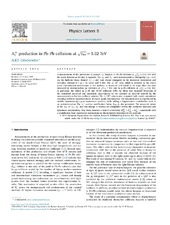Λc+ production in Pb–Pb collisions at √sNN = 5.02 TeV
Acharya, Shreyasi; Acosta, Fernando Torales; Adamová, Dagmar; Adhya, Souvik Priyam; Adler, A.; Adolfsson, Jonatan; Aggarwal, Madan M.; Aglieri Rinella, Gianluca; Agnello, Michelangelo; Agrawal, Neelima; Alme, Johan; Altenkaemper, Lucas; Djuvsland, Øystein; Ersdal, Magnus Rentsch; Fionda, Fiorella Maria Celeste; Nystrand, Joakim; Rehman, Attiq ur; Røhrich, Dieter; Tambave, Ganesh Jagannath; Ullaland, Kjetil; Wagner, Boris; Yuan, Shiming; Zhou, Zhuo; Arsene, Ionut Cristian; Bätzing, Paul Christoph; Dordic, Olja; Lardeux, Antoine Xavier; Lindal, Svein; Malik, Qasim Waheed; Richter, Matthias; Røed, Ketil; Skaali, Toralf Bernhard; Tveter, Trine Spedstad; Wikne, Jon Christopher; Zhao, Chengxin; Helstrup, Håvard; Hetland, Kristin Fanebust; Kileng, Bjarte; Nesbø, Simon Voigt; Storetvedt, Maksim Melnik; Langøy, Rune; Lien, Jørgen André; Ahammed, Zubayer; Ahmad, Shafiq F.; Ahn, Sang Un; Aiola, Salvatore; Akindinov, Alexander; Al-Turany, Mohammed; Alam, Sk Noor; De Albuquerque, Danilo Silva; ALICE, Collaboration
Peer reviewed, Journal article
Published version

Åpne
Permanent lenke
https://hdl.handle.net/1956/21664Utgivelsesdato
2019-04-23Metadata
Vis full innførselSamlinger
Originalversjon
https://doi.org/10.1016/j.physletb.2019.04.046Sammendrag
A measurement of the production of prompt baryons in Pb–Pb collisions at TeV with the ALICE detector at the LHC is reported. The and were reconstructed at midrapidity () via the hadronic decay channel (and charge conjugate) in the transverse momentum and centrality intervals GeV/c and 0–80%. The ratio, which is sensitive to the charm quark hadronisation mechanisms in the medium, is measured and found to be larger than the ratio measured in minimum-bias pp collisions at TeV and in p–Pb collisions at TeV. In particular, the values in p–Pb and Pb–Pb collisions differ by about two standard deviations of the combined statistical and systematic uncertainties in the common interval covered by the measurements in the two collision systems. The ratio is also compared with model calculations including different implementations of charm quark hadronisation. The measured ratio is reproduced by models implementing a pure coalescence scenario, while adding a fragmentation contribution leads to an underestimation. The nuclear modification factor, , is also presented. The measured values of the of , and non-strange D mesons are compatible within the combined statistical and systematic uncertainties. They show, however, a hint of a hierarchy , conceivable with a contribution from coalescence mechanisms to charm hadron formation in the medium.
